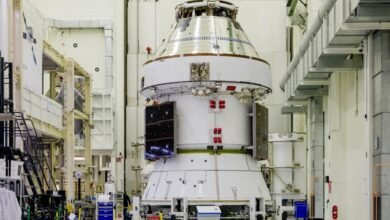NASA’s Silent Supersonic Jet Makes Historic First Flight

▼ Summary
– NASA’s X-59 supersonic jet completed its first flight in the Mojave Desert, aiming to reduce sonic boom noise for future commercial supersonic travel over land.
– The jet, built by Lockheed Martin, took off from Palmdale, California, and its airworthiness was validated during the hour-long test flight piloted by NASA’s Nils Larson.
– NASA’s acting administrator described the X-59 as a symbol of American ingenuity and the pursuit of faster, quieter aviation technology.
– Current US regulations prohibit commercial supersonic flights over land due to disruptive sonic booms that can affect communities on the ground.
– Sonic booms occur when shock waves form as an aircraft breaks the sound barrier, creating high-pressure waves that produce a loud double thunderclap.
A new chapter in aviation history unfolded above the Mojave Desert as NASA’s X-59 Quiet SuperSonic Technology (QueSST) aircraft completed its inaugural flight, marking a pivotal step toward reintroducing commercial supersonic travel over populated areas. This experimental jet, developed to dramatically reduce the disruptive noise associated with breaking the sound barrier, lifted off from US Air Force Plant 42 in Palmdale, California, shortly after sunrise. Piloted by NASA’s chief test pilot Nils Larson, the successful maiden voyage confirmed the aircraft’s fundamental airworthiness and handling characteristics before it touched down approximately one hour later near NASA’s Armstrong Flight Research Center in Edwards.
Acting NASA Administrator Sean Duffy described the X-59 as an emblem of American innovation, stating the project reflects a deep-seated drive to push boundaries in speed and silence. The aircraft was constructed by Lockheed Martin’s advanced development division, Skunk Works, known for producing some of the world’s most sophisticated aerospace vehicles.
Current US regulations forbid commercial aircraft from traveling faster than sound over land because of the loud sonic booms generated, which can startle communities and cause minor structural vibrations. This restriction famously confined the Concorde, the only previous commercial supersonic airliner, to transoceanic routes. The core challenge lies in the physics of supersonic flight: as an aircraft nears the speed of sound, pressure waves accumulate around its frame. Once it crosses that threshold, these waves merge into powerful shockwaves that travel to the ground, producing the characteristic dual thunderclap of a sonic boom.
The X-59 program aims to reshape these shockwaves into a much gentper pressure rise, heard on the ground as a soft thump rather than an explosive bang. By demonstrating this “quiet” supersonic technology, NASA hopes to gather data that could convince regulators to rewrite the rules, ultimately allowing a new generation of faster passenger planes to fly overland routes. This first flight represents a crucial initial milestone, with many more test flights planned to collect the necessary acoustic and performance data.
(Source: Wired)


